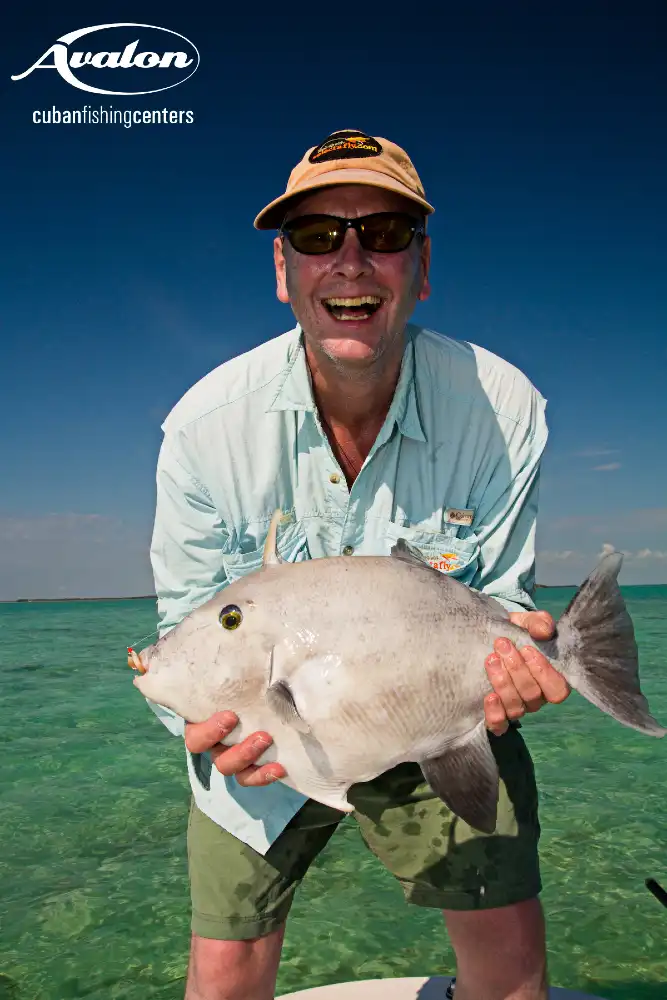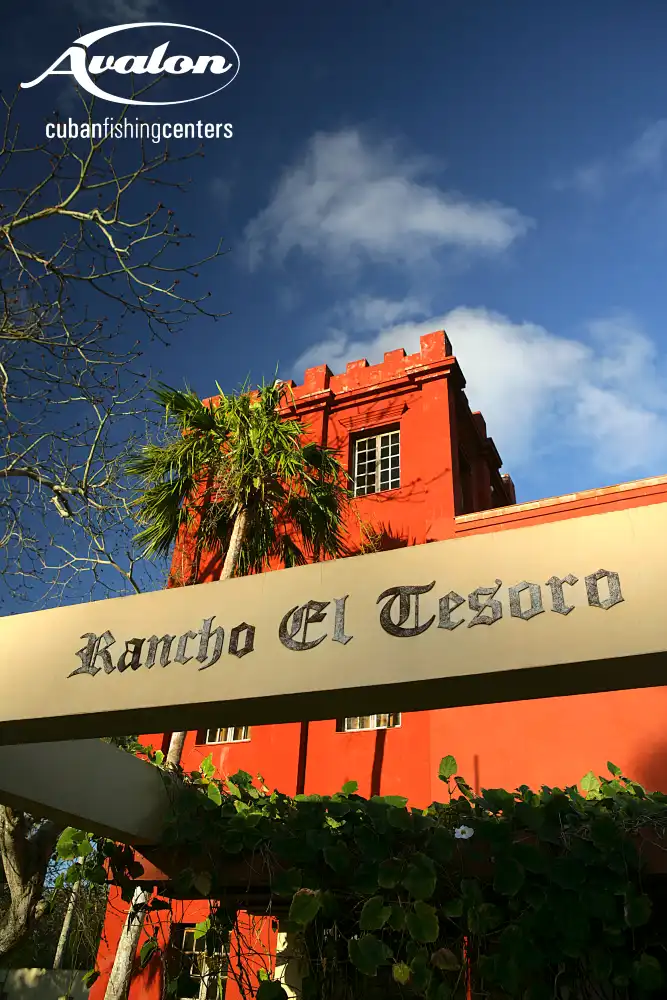CUBA
FLY FISHING
THE JEWEL OF THE CARIBEAN
Fishing in Cuba is a delight and a continual mixture of incomparable sensations. In the exclusive fishing centers of AVALON at Jardines de la Reina (Gardens of the Queen), Isla de la Juventud (Island
of Youth), Cayo Largo (Long Key), and at our newest destination on Cayo Cruz, you will be tempted with the most combative and acrobatic species, while enjoying the exclusiveness of a vast area of endless flats just for you. This is a unique and incomparable combination that Avalon offers their clients-fishing in their own marine park on the southern coast of Cuba.
There is no doubt that this is a once in a lifetime opportunity. Imagine being able to choose the place where you want to fish, and go after the species you want and to do so accompanied by the most experienced and knowledgeable guides.
These guides spend almost 250 days every year guiding visitors and ensuring that their
guests enjoy all the benefits and opportunities that this amazing environment offers. These they are some of the species that you can fish in Avalon, Cuba: Bonefish or Macabi, Tarpon or Sabalo, Permit or Palometa, and other ones like Snappers, Jacks, Snooks Barracudas, Needlefish or the combative and voracious Lemon sharks.
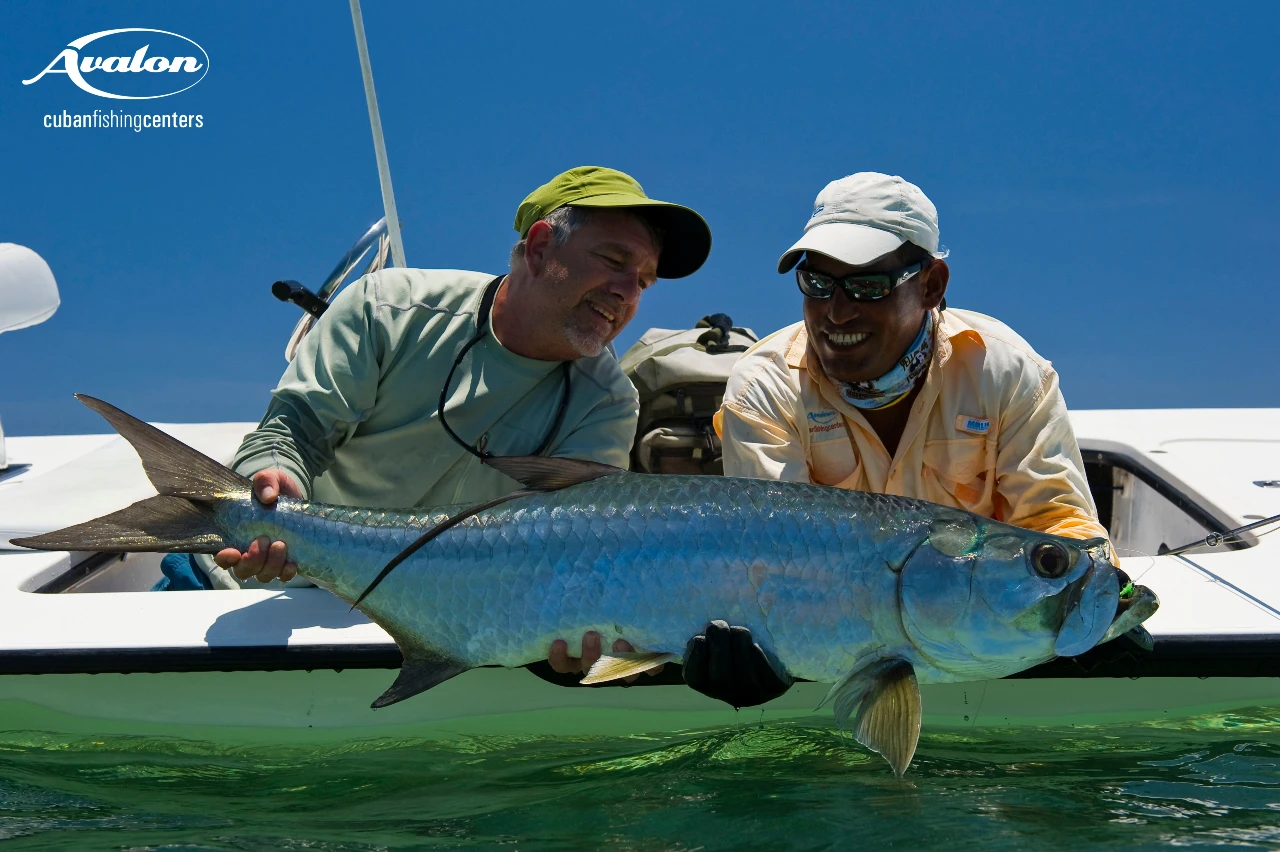
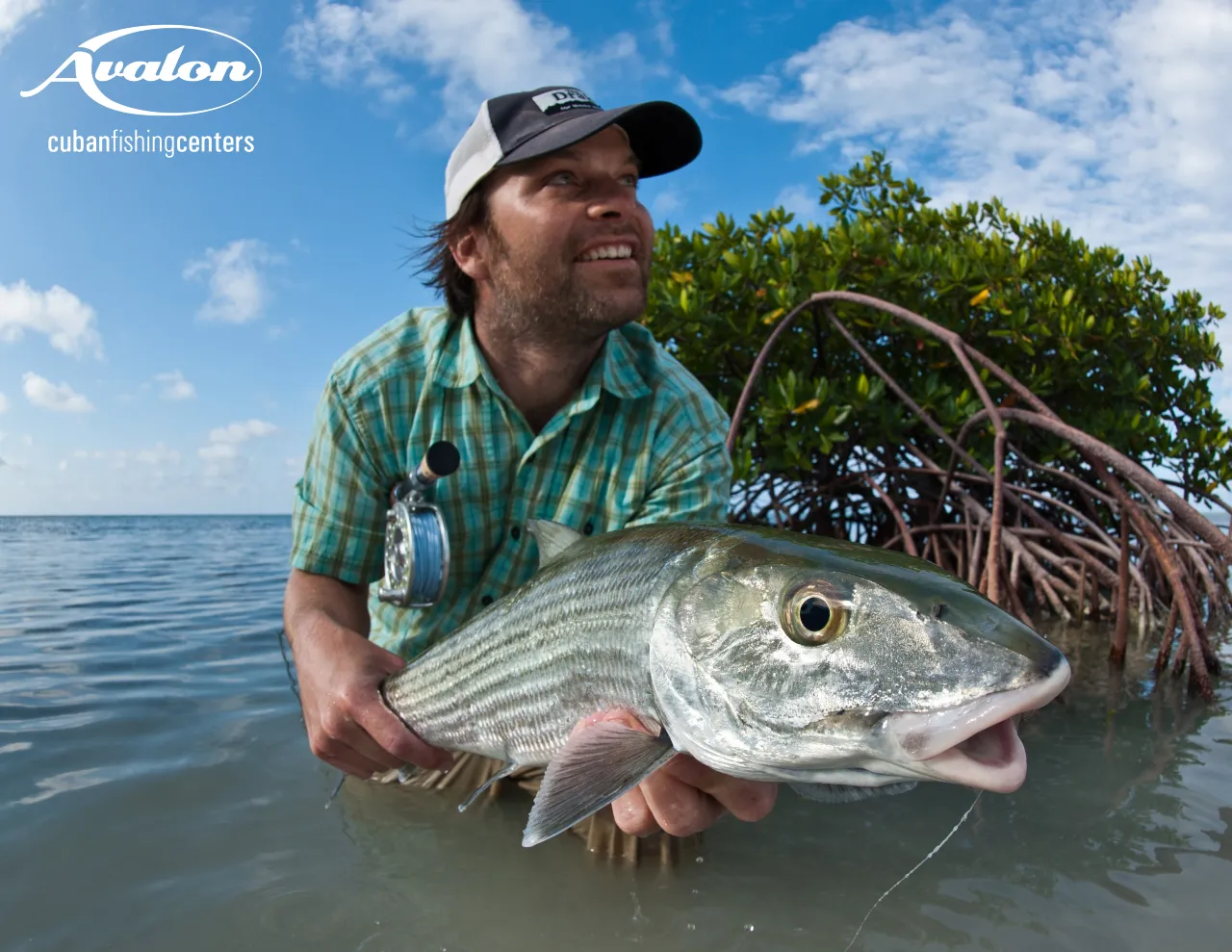
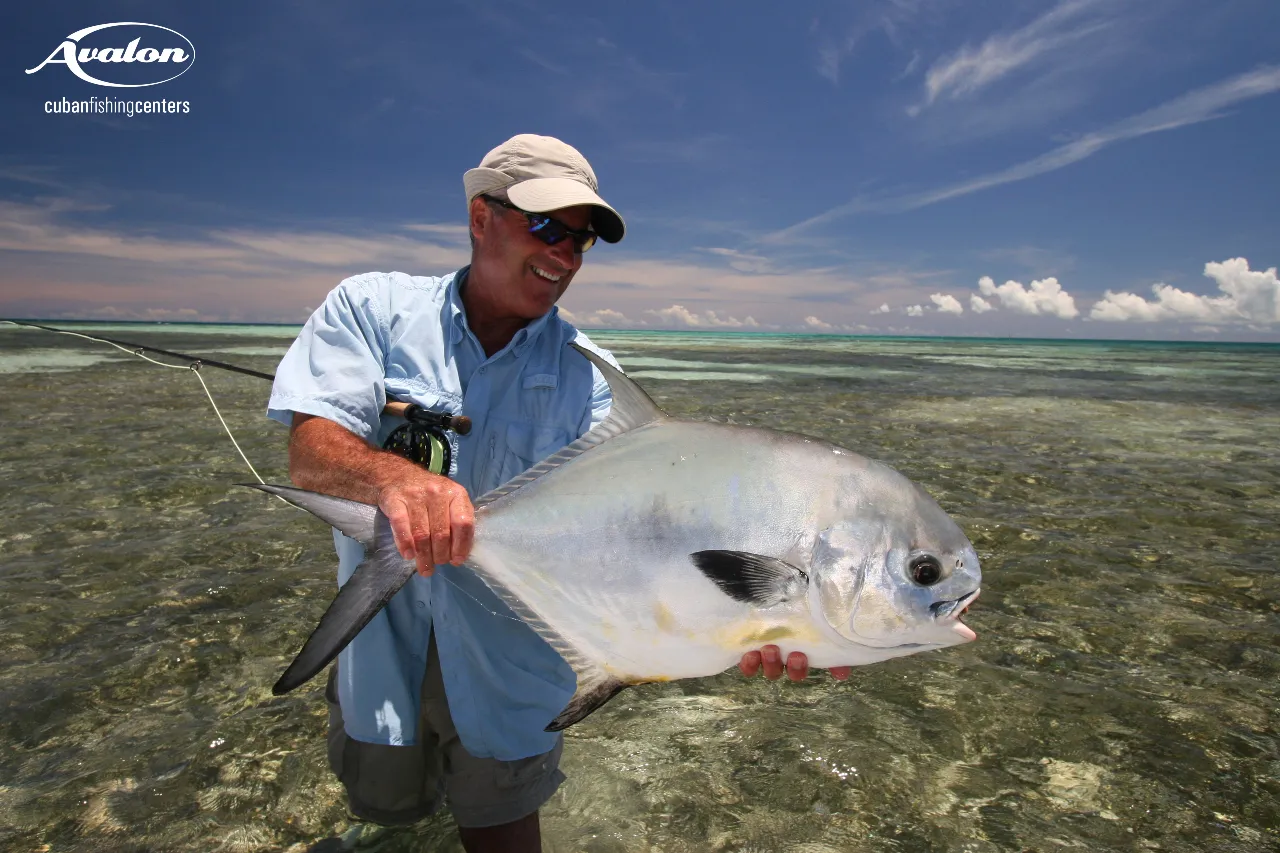
CUBA IS FAR DIFFERENT FROM OTHER DESTINATIONS IN THE CARIBBEAN
Despite heavy commercial fishing pressure before the ban, Cuba’s remote archipelagos have remained unspoiled. This is because they are often situated from 50 to 100 miles off the Cuban coast and are not easily visited, even by the Cuban lobster fishermen. Under the tutelage of several famous guides and anglers, the Cubans have become excellent guides and good fly fishermen.
Give them a fly rod and they‘ll double-haul a 100-foot cast or show you just how to work a fly to make a bonefish charge and inhale it. They spot fish as well as any of the Caribbean’s best guides and direct your casts from the poling platform. These guides enjoy enthusiastic anglers and love to work long days, allowing you to fish as hard as you want.
A remarkable contrast to many other destinations where you are often limited to 6 or 8 hours on the water, including your running time. In Avalon’s destinations, there is never any limitation on gas used or distances run in the day If you want to get out early and fish to dark, you can do it! But the fishing is normally so good and so intense that you’ll be ready to quit in time to be back for cocktails. Although Spanish is the guides’ native tongue, they have all taken classes in English and they communicate surprisingly well with their anglers. They are also in constant training to improve their language skills.
FLY FISHING
Fly fishing in Cuba is far different from other destinations in the Caribbean. Only in recent years has this flats fishery been developed, and you are fishing waters that have not seen sport fishing for nearly fifty years.
Cuba has given these pristine areas protection as Cuban National Marine Parks, where no commercial fishing is allowed other than for lobster. Flats fish like Tarpon, Permit, Bonefish, Snook, Mutton Snapper, Barracuda, and a variety of Jacks are found in incredible numbers and since the fishing pressure is so light in these areas the fish rarely encounter sport fishermen and are unusually easy to catch.
Think about a place where you can fish more than 100 miles of flats without seeing another fisherman. A place where the flats fishing is so good, you can catch seven species of fish in one day. A place where big
Bonefish run toward your fly even when it hits the water too hard, rather than streaking off the flat in the other direction.
A place where you have a legitimate chance for a Grand Slam every day of the year. A place where big Permit are as plentiful as they were in the Florida Keys 30 years ago, and here they take absolute pleasure in eating your fly! Jardines de la Reina is an incomparable location of barefoot wadeable white sand flats where you‘ll find enough big Bonefish, Permit, Tarpon, Jacks, Cudas, and Sharks on the flats for
lifetimes of fishing!
THE FISHERY
TARPON
“BRUTAL“ IS THE RIGHT WORD TO DESCRIBE FLY FISHING FOR TARPON
The King of Silver has an insatiable appetite, and gets very violent. Tarpon take with power, and show stamina and acrobatic qualities that make tarpon a formidable adversary on a fly rod. Fishing Tarpon or Sabalo, as it is known in Cuba, can be divided into three categories: Baby Tarpon (those that they weigh up to 30 Lbs), Medium Tarpon (those that weigh 30 Lbs up to 80 Lb) and Monster Tarpon (those of more than 80 Lb and sometimes can surpass the incredible mark of 150 Lbs). Obviously, the last category is hunted hard, but unfortunately these behemoths are much less common.
When nearing a school of Tarpon, holding an 11 or 12 wt. rod, legs shake and a matchless sensation of adrenalin invades the body, as you anticipate a battle with one of these marine monsters. Sighting and casting accurately play a major role as the angler must reach the school of Tarpon that swim slowly in a circle within meters of the boat. At all times it is important to control one‘s nervousness and to never feel intimidated by the presence of these extraordinary beasts.
The beginning of the road to success is to strip strike the fish precisely and firmly. the violent reaction of the Tarpon when it feels the fly in its mouth is going to send him skyward. so you have to bow to the king to keep that line slack and then hold your rod low and keep him under control – easier said than done.
PERMIT
FABULOUS ADVERSARY
No one is ever able to guarantee success with Permit; however, with a little ingenuity and teamwork between guide and angler, dreams and life long pursuits can be realized with great joy! This wonderful fish is the ultimate flats challenge and many fly fishermen have been taken to school by this wary fish.
To cast to, hook, and land a permit on a fly is a true angling milestone and one that most fly fishermen who have fished the salt will eventually aspire to. It is a gift that with patience, agility, modesty, and great humility, a lucky few will be rewarded. Fly fishing for Permit is extremely challenging and the odds are often stacked against the intrepid angler who looks to target this fabulous adversary.
Wind, sun and the erratic nature of this fish all conspire against fly fishermen in their quest to tail one of these majestic fish. We can think of no other fish that is so difficult to predict, to understand, and worse still, to deceive. What a challenge! The best locations in Cuba to consistently find permit are in Cayo Largo and Jardines de la Reina. Both of these locations are 60-80 miles offshore, along Cuba‘s southern coast. The optimal times to fish for permit in Cuba are between March and July, as well as in the month of November, when the tides are high.
BONEFISH
AMAZING COMBATIVE FISH
The bonefish population in JDR are healthy and abundant. The average size is typically between 4 and 6 pounds with many reaching double digits. The color of bonefish can range from very silver sides and slight darker backs to olive green backs that blend to the silver side.
Slight shading on the scales often lead to very soft subtle lines that run the flank of the fish from the gills to the tail. The bases of the pectoral fins are sometimes yellow. An amphidromous species, it lives in inshore tropical waters and moves onto shallow mudflats to feed with the incoming tide. Adults and juveniles may shoal together, and they may be found singly or in pairs.
The Bonefish prefers areas of shallow water along the coast. It can be located in depths between centimeters and 2 meters. Normally, it is possible to see them swim in schools of fish with numbers between 4 and 20. This grand specimen has a solitary life. They are fish that reproduce throughout the year in open waters. Nevertheless they return quickly to the coast. They are fish that have a great tolerance to waters with little oxygen since they have a biofunctional characteristic that allows them to do so. The Bonefish must never be fought with extreme force, since this could break the line. The fisherman must finesse the fight and tire but not exhaust the fish, so he can be released unharmed to swim another day.
THE GRAND SLAM
Cayo Largo and JDR are both outstanding locations for producing Grand Slams and Super Slams, in large part because the permit fishing is consistently so good. Each of these fisheries regularly produce 25 pound + permit for our anglers and we don‘t know of too many other places that boast the number of weekly Slams that Cayo Largo and JDR do.
Further west, Isla de la Juventud is fast becoming known as a Mecca for huge permit taken on a fly and we would not be surprised to see a record come from this location in the near future. Anglers in these locations will periodically find permit tailing on the flats in 1 to 2 feet of water. A far more common way to find permit is to go looking for sting rays feeding in 2 to 3 feet of wa- ter. Permit are intelligent, opportunistic feeders. They will follow behind sting rays, using the rays to flush out crabs and shrimp which the permit will then eat before the ray has a chance to get its meal.
Cuba‘s south coast permit can also be found swimming with large schools of bonefish. This scenario presents its own set of challenges because bonefish will often take the fly before the permit has a chance to eat it, unless the fly is cast to just the right location. This kind of precise angling will get your heart pounding and put all your fly fishing skills to the test.
OTHER SPECIES
Jack Crevalle and Horse Eye Jacks are wonderful game fish, and are very abundant in the JDR. It is common to see a school of big jacks patrolling the flats, eating everything in sight. Many of these fish are in the fifteen to twenty pound class with some right up to the thirty pound mark.
Theylooksomewhat like the permit, being in the same family, but Jacks are one of the most aggressive feeders on the flats and very easy to catch in relation to permit. As a bonus, the Horse Eye jacks make wonderful sashimi back on the boat before dinner. Cudas and Sharks Big Cudas are plentiful around all the bonefish flats.
Most will be three to four feet long, and will give any fly angler a terrific fight. Their aggressive take is exciting and few fish can swim faster or jump farther than a big barracuda. They are easy to catch on the many good needlefish patterns, using a wire leader.

DESTINATIONS
This vast marine park, which is bigger in size of the Florida Keys, is ideal for fly-fisherman who wish to live and experience fishing from dawn till dusk. Here we offer more fishing hours than any other destination. Jardines is for those looking for adventure, absolutely amazing food with fresh seafood every day, and complete comfort.
Our live aboard options are as follows: The Jardines Avalon IV, our spacious floating hotel, Jardines Avalon III, Jardines Avalon II, Jardines Avalon I, Jardines Avalon F II, Jardines Avalon F I and for smaller groups, we offer Perola. We advise that guests fly directly to Santa Clara, Camaguey or Cayo Coco airports. Here you will be met by a representative that will transfer you to the Jucaro port. These transfers are between 2 and 3 hours. If guests choose to fly into Havana, they will be transferred to Jucaro port (5 hours) on Saturday of their fishing week.
If you are staying aboard Jardines Avalon III, Jardines Avalon II, Jardines Avalon I, Jardines Avalon F II, Jardines Avalon F I or Perola you will board your mothership vessel at Jucaro port. Guests that will be on the Jardines Avalon IV for the week must arrive to Camaguey, Santa Clara or Cayo Coco airports in the morning on Saturday for transfer to Jucaro port where they will board the transfer ferry for a quick three hour transfer to Jardines Avalon IV that leaves promptly at 2pm. If guests are arriving in the afternoon, they must arrive on Friday.
Guests on these programs can enjoy their fishing dreams from the minute they step aboard, and will be able to fish more hours and more species than in any other Caribbean destination. Here you will cast for large Tarpons (perhaps less BIG tarpon than on Isla de la Juventud, but more classic flats fishing for big tarpon and more variety). JDR is full of everything – Tarpon of all sizes, Permit, bones, Jacks, Barracuda – you name it. JDR is the favorite fishery of all destinations for many anglers around the world. The fishing hours are totally at the discretion of the clients.
Our regular fishing day usually begins with breakfast at 7:00am, and your guides will be ready to depart for fishing from 7:45 am on. Most of the flats you will fish are within fifteen minutes of the yacht or accommodation, and it is always nice to take a lunch break in the comfort and shade, back on board the boat. Relaxing for an hour or so before fishing the long afternoons, especially during the warm summer season, is always a good idea.
Many of the more remote flats can produce outstanding fishing and your guides will suggest the evening before that you pack a lunch and stay out all day in order to access some of the more distant flats and estuaries. Clients can fish late into the evening if they like, since it is usually only a short run to get back to their mothership yacht. In Jardines, the morning winds often calm down in the afternoons, and fishing in the late afternoon can be superb, especially for bonefish or tarpon.
There is never a daily gasoline limitation for our guides, so you can run longer distances to fish remote flats, especially on those days when you opt to stay out all day. Our season in the Jardines de la Reina is YEAR ROUND. Our weeks on board the yachts run from Saturday to Saturday. Our normal fishing program includes five full days of fishing and one half to three quarter days of fishing on Friday before you return to the mainland for your final night aboard your vessel in Jucaro.
BLUE SANCTUARY AND GARDENS OF THE QUEEN
Blue Sanctuary has been working with partners in the Jardines de la Reina Archipelago for the past 27+ to 30 years. This is the largest no take marine preserve in the Caribbean, to focus on research, management and economic issues related to what are considered the most healthy and extensive coral reefs in the Caribbean region.
We are working closely with the Cuban Center for Coastal Ecosystems and Marine Research Center of Cuba to better study the natural resources of the region while also assessing their economic and social values. Project Gardens of the Queen is a comprehensive, aggressive and forward-looking program to research and protect the unique and pristine ecosystems of Jardines de la Reina.
This research ensures that these protections will endure in perpetuity, serve as a compelling model for marine protected areas worldwide, dramatically advance human understanding of how healthy coral reef ecosystems function, and yield critical insights to inform management decisions for protecting coral reefs globally. Furthermore, this ecosystem and educational research model is bringing Americans and Cubans closer together.
Former fishermen and their families are now employed in diving and fly fishing operations. Through this they are continually creating human connections by educating visiting ecotourists creating a sustainable way of life; which in turn, is fostering future generations of stewards in this marine park.
As of April 1st, 2008 the incredible Cayo Largo (Long Key) fishery came under the management of Avalon Fishing Center. With this new undertaking we strive to achieve a paradise that fishermen can enjoy and share with their families and non-fisherman friends. In Cayo Largo you can bonefish on white sand flats while your family enjoys the breathtaking beaches, enjoy a cocktail in the hotel pool, or participate in one of the numerous activities the resort offers.
Fish during the day and relax while watching an incredible sunset in style and comfort in one of the most beautiful pristine natural environments in the world. When you combine this stunning eco system with the personal touch and excellent service that Avalon is renowned for, our 15 years of experience in providing top notch fly fishing trips you are guaranteed a great experience. One of the great benefits to this destination is that Cayo Largo also has a modern international airport where Canadian, European, and South American aircraft can now fly to directly. There are 3 weekly flights directly from Canada and Italy.
This is one of the few companies in the world that can offer its guests the unique ability to fish in a completely exclusive marine park, free of commercial fishermen, nets or any skiffs or yachts from other companies. Think about the incredible possibilities of having all those nautical kilometers to yourself and being able to choose the species and the places you want to fish, without any fuel limitation during your fishing week. Guests can expect the following species when fishing with Avalon at Cayo Largo: Permit, Bonefish (large ones), Tarpon, Jack Crevalle, Barracudas, Mutton Snapper, Snooks, etc.
The bounty of nature found at Cayo Largo is a well-kept secret. It has pristine coral reefs and is complemented by neighboring keys inhabited by numerous species of flora and fauna, among them iguanas, pelicans and turtles. The beginning of the season from November to January is very good, with plenty of bonefish (especially big ones) on the flats and mangrove areas. Fishing for tarpon and other species can also be excellent. This is a really nice time to plan a trip to Cayo Largo, as the weather is much warmer in Cuba than in Europe or Northern America. Our high season from February through July offers stable and perfect fishing conditions with all species present. During this period, our Cayo Largo program is based on the JA1 live aboard to afford the most convenient logistics and ease of access to the most productive fishing areas.
SEASON:
Peak fishing season is from February to July, when all species are present in the area. Tarpon, bones, permit and jacks will all be encountered during these months. The migratory tarpon, up to 80/100lbs (average 15/30lbs) are regularly spotted and shots at permit are very frequent. Our peak season is the best time to try the Gland Slam. Numerous Grand Slams are achieved each season as well as a few Super Grand Slams (Tarpon, Bonefish, Permit and Snook).
In the late part of the season, the weather gets hot but the fishing is still very productive, especially for tarpon and permit. Fishing for bonefish is also very good in the morning and in the evening. Our statistics indicate a very surprising summer phenomenon: that the same number of fish are caught during the hot months as in the peak season, but by half the number of rods. This illustrates how fabulously productive the summer months in Cayo Largo can be for our anglers.
BLUE SANCTUARY AND CAYO LARGO
Blue Sanctuary has been working with partners in the Canarreos Archipelago for the past 27+ years. This is a massive no take marine preserve in the Caribbean, to focus on research, management and economic issues related to what are considered the most healthy and extensive coral reefs in the Caribbean region.
We are working closely with the Cuban Center for Coastal Ecosystems and Marine Research Center of Cuba to better study the natural resources of the region while also assessing their economic and social values. Project Blue Sanctuary is a comprehensive, aggressive and forward-looking program to research and protect the unique and pristine ecosystems of the Canarreos Archipelago.
This research ensures that these protections will endure in perpetuity, serve as a compelling model for marine protected areas worldwide, dramatically advance human understanding of how healthy coral reef ecosystems function, and yield critical insights to inform management decisions for protecting coral reefs globally. Furthermore, this ecosystem and educational research model is bringing Americans and Cubans closer together.Former fishermen and their families are now employed in diving and fly fishing operations. Through this they are continually creating human connections by educating visiting ecotourists creating a sustainable way of life; which in turn, is fostering future generations of stewards in this marine park.
Located on the north shore of the eastern province of Camaguey, the Cayo Romano fishery is an enormous system of flats, lagoons and pristine estuaries. Located in Jardines del Rey, commercial fishing within this designated area is strictly forbidden and rigorously enforced.
The sportfish – only area is 366 square kilometers in size, meaning that on the average day, each skiff has over 50 square kilometers to itself. The fishing area is virtually untouched and represents one of the cleanest and most biologically diverse ecosystems we’ve ever fished. This is one of the other reasons we have chosen this destination.
It is still pretty much untouched and has only seen a very limited number of anglers since 2011. Most other destinations in the Caribbean have been heavily overfished for decades. Also, those concerned by the occasional cold fronts from the north during January to March can be assured that Cayo Romano is privileged in having an extensive string of cays on its northern border which protects it from all but the most violent of weather patterns.
NEW EXCLUSIVE ACCOMMODATIONS
The ROMANO is a stunning new accommodation in Cayo Romano. With a privileged location, at only 100 meters from the fishing marina, this new private mini lodge has a swimming pool, bar, lounge, a variety of signature restaurants, bowling area, and more. This lodge features several activities for anglers and also for non fishing guests. Additionally, the accommodation is only 1 hour away from Cayo Coco airport.
The lodge is built right on the water, overlooking a beautiful channel visited daily by tarpon schools and jacks. Some of the best fishing takes place right off the marina before dark. All rooms are spacious and well appointed with air conditioning, tile floors and nice showers. The Romano has a private block of rooms specially assigned to the Avalon anglers, in a quiet area. In the open-air main lodge you will find comfortable lounging chairs and a fully stocked bar with an accommodating bartender.
After a long day on the flats it’s nice to recount your adventures to fellow anglers while sipping an ice-cold beverage and enjoying the daily selection of snacks prepared fresh every afternoon. After a shower, make your way to the dining room to enjoy the chef’s daily specialty. This accommodation offers a “lodge atmosphere” to anglers who visit it, as it is remote but not disconnected. The main lodge has wireless internet for guest use. Come down and enjoy yourself at Cayo Romano.
GUIDES:
Cayo Romano has been in operation since 2011 and has not seen many clients. This leads to a completely unpressured fishing area where the guides have free range to explore and share the bounty of this flats oasis. Many of Avalon’s guides have worked in this area previously as commercial fishermen and have grown up among these flats, lagoons, and mangroves.
Because of this deep history and wealth of knowledge, along with Avalon’s professional and progressive training measures, this area features some of the best and most competent guides in all of Cuba and the Caribbean. Our guides speak good English and are eager to share stories about their Cuban heritage and unique fishing experiences. These guides will go the extra mile for each and every one of our clients while exhibiting a passionate drive towards success while pursuing the fish of a lifetime.
GENERAL PROGRAM
The skiffs depart from Cayo Romano each morning and depending on the guide rotation that day, you may be heading to any number of areas to spend the day.
From Cayo Paredon Grande in the north to Cayo Guanaja in the south, there are countless islands, lagoons and bays that will keep anglers happy and into fish. Much of the fishing takes place back towards the mainland, in and around the massive island of Cayo Romano.
The average boat run to the fishing areas is about 20 minutes in length and in some areas, you can be into fish within 5 minutes of leaving the boat docks.
It just depends on where your guide wants to take you that day and what you are interested in targeting. With 50 square kilometers per boat, the options are just about limitless. There are so many great aspects to this fishery that it can truly be a sensory overload at times.
FLY FISHING
The first thing that guests need to know about when considering this location, aside from the exceptional flats fishing that is found here is that this new fishery is still very much in its infancy. The flats are an inviting combination of hard packed white sand and a semi-firm mottled bottom that still provides good wading. And what a place this is for those who like to wade! It’s very similar to Los Roques in terms of the amount of area that’s wadable and there are places here where you can wade for 4 straight hours without heading back to the boat.
Cayo Romano demonstrates all the characteristics of a recently discovered, virgin fishing territory – large numbers of fish, good sizes and their evident lack of exposure to flies and leaders. Add to this the natural beauty of the cays and of the water and you have a truly memorable place to fish. The average sized bonefish is a healthy 4 pounds and during the course of the week it is not unheard of for guests to land a fish or two in the 10 pound range.
Tailing bonefish are common and guests can expect to see bonefish in singles and doubles, all the way up to schools of several hundred fish. What really sets this location apart from so many other fisheries is that guests can expect to encounter and get shots at good numbers of permit each day. There are very few places on earth where guests can fish for big bonefish each day and get shots at tailing permit. This combination may take place in other locations but not with the consistency that is virtually guaranteed at Cayo Romano.
It is a rare day when you don’t encounter and get shots at permit. The permit will range in size between about 8 and 30 pounds. The flats at Cayo Romano are a little deeper than those found in other areas of Cuba, which means that the bonefish and permit are still found in excellent numbers throughout the year. There are two locations within the Cayo Romano that offer very good tarpon fishing. Guides tend to save these areas for when an angler has already boated a permit and is looking for a Grand Slam.
These fish will range from 30 to 90 pounds. Besides the fishing for permit, bonefish and tarpon, you will also cast for other challenging species as mutton snapper, snook, cubera, snapper, jack crevalle, barracuda, etc.
SEASON:
The period January to March brings with it the risk of cold fronts from north-east. However, as explained above, Cayo Romano is well protected by the string of cays that shelter most of the fishing spots. The fishing at this time is good; particularly for good-sized bonefish, small and medium tarpon (20-30lbs), and from mid-January the permit begin to appear.
The period from April to June is perhaps the best time both for weather and for appearance of large quantities of huge tarpon, in addition to the bonefish and permit. In July and August the fishing is much the same as the spring and early summer with increased numbers of Permit on the flats and many opportunities to target them with many shots per day. September to December is a great time for all species with many bonefish and permit on the flats and the occasional opportunity for tarpon among the multitude of other species available.
BLUE SANCTUARY AND CAYO ROMANO
Blue Sanctuary has been working with partners in the Jardines del Rey Archipelago for the past 27+ years. This is a massive no take marine preserve in the Caribbean, to focus on research, management and economic issues related to what are considered the most healthy and extensive coral reefs in the Caribbean region.
We are working closely with the Cuban Center for Coastal Ecosystems and Marine Research Center of Cuba to better study the natural resources of the region while also assessing their economic and social values. Project Blue Sanctuary is a comprehensive, aggressive and forward-looking program to research and protect the unique and pristine ecosystems of the Jardines del Rey Archipelago.
This research ensures that these protections will endure in perpetuity, serve as a compelling model for marine protected areas worldwide, dramatically advance human understanding of how healthy coral reef ecosystems function, and yield critical insights to inform management decisions for protecting coral reefs globally. Furthermore, this ecosystem and educational research model is bringing Americans and Cubans closer together.
Former fishermen and their families are now employed in diving and fly fishing operations. Through this they are continually creating human connections by educating visiting ecotourists creating a sustainable way of life; which in turn, is fostering future generations of stewards in this marine park.
This marine park is located at approximately the same longitude as Havana and is the largest island to the south of mainland Cuba. To reach our destination on Isla de Juventud (Isle of Youth), Avalon flies customers from Havana in a comfortable and safe helicopter then transfers them out on a short drive to the mothership, Jardines Avalon F I. Isla de Juventud hosts the ideal program for fisherman with an obsession for monster Tarpon.
The fishing style is a mix of sight casting for Tarpon and other species and blind casting into channels for monster Tarpon. Between March and June we have caught and released Tarpon around 100 pounds; the fishing always exceeds our expectations. Anglers must arrive and overnight in Havana on the Friday directly before the fishing week. On Saturday, they will fly to Isla de Juventud where they will enjoy seven nights and six full days of fishing and luxury aboard the Jardines Avalon F I mothership.
On the following Saturday, guests will fly to Havana where they will overnight and fly home on Sunday. The round trip flight between Havana and Isla de Juventud is included in the fishing package.
EXCLUSIVE ACCOMMODATIONS WITH PERSONALIZED SERVICE
Jardines Avalon F I is an intimate, comfortable, and stylishly designed yacht, where each space is created to provide its guests with maximum comfort and safety. The atmosphere was conceived and designed to provide our guests with an experience of a lifetime. Its overall capacity is 20 passengers and 8 crew members.
We suggest this yacht for groups between 8 and 14 anglers for optimum comfort. The design and interior decor give the yacht a touch of intimacy, refinement, a sense of warmth and simplicity. The boat has the perfect balance of substantial exploration capabilities and a unique and noble style. It guarantees all our guests a pleasant, exciting and exclusive voyage through Isla de la Juventud.
Jardines Avalon F I has 8 deluxe king cabins, with 7 private bathrooms. Each room includes air conditioning and heat controls, electricity plugs, as well as storage in drawers. Each room has panoramic windows to enjoy the breathtaking view of the Caribbean beaches. There is a spacious and comfortable combination lounge, dining room and bar area on the boat deck. In cabins and common areas there are electric sockets available for you to plug in your personal items (220 volts and 110 volts).
Cuisine on board the Jardines Avalon I is exceptional. Fresh fish of the day is utilized for most meals, either caught by the anglers themselves or harvested by the crew. Lobster and Conch are abundant can be had on a daily basis from the surrounding waters. Salads with fresh vegetables and a variety of fruits are always available.
In addition, you‘ll have excellent pork and chicken entrees during the week, fresh sashimi for appetizers and some of the finest frozen Daiquiris known to man. Traditional Cuban flan topped off with aged Havana Club Rum is one of the many unique and delicious deserts served, and you can have seconds on anything your heart desires!
Book now your next unforgettable fishing in Cuba:
✅ CONFIRMED WITH A 50% DEPOSIT
✅ BALANCE DUE 30 PRIOR TO THE TRIP














